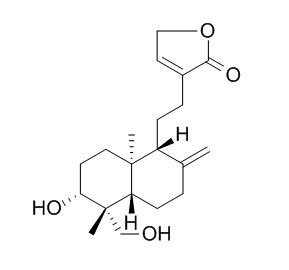14-Deoxyandrographolide
14-Deoxyandrographolide has hepatoprotective activity, mediates activation of adenylate cyclase-cAMP signaling leading to up-regulation of cNOS, may provide a promising approach in the prevention of liver diseases during chronic alcoholism. It desensitizes hepatocytes to TNF-alpha-mediated apoptosis through the release of TNFRSF1A.
Inquire / Order:
manager@chemfaces.com
Technical Inquiries:
service@chemfaces.com
Tel:
+86-27-84237783
Fax:
+86-27-84254680
Address:
1 Building, No. 83, CheCheng Rd., Wuhan Economic and Technological Development Zone, Wuhan, Hubei 430056, PRC
Providing storage is as stated on the product vial and the vial is kept tightly sealed, the product can be stored for up to
24 months(2-8C).
Wherever possible, you should prepare and use solutions on the same day. However, if you need to make up stock solutions in advance, we recommend that you store the solution as aliquots in tightly sealed vials at -20C. Generally, these will be useable for up to two weeks. Before use, and prior to opening the vial we recommend that you allow your product to equilibrate to room temperature for at least 1 hour.
Need more advice on solubility, usage and handling? Please email to: service@chemfaces.com
The packaging of the product may have turned upside down during transportation, resulting in the natural compounds adhering to the neck or cap of the vial. take the vial out of its packaging and gently shake to let the compounds fall to the bottom of the vial. for liquid products, centrifuge at 200-500 RPM to gather the liquid at the bottom of the vial. try to avoid loss or contamination during handling.
Mol Med Rep.2014, 9(5):1653-9
Molecules.2022, 27(7):2116.
J Agric Food Chem.2018, 66(1):351-358
Evid Based Complement Alternat Med.2021, 8707280.
ACS Omega.2023, 8(36):32424-32431.
Biomed Pharmacother.2024, 179:117395.
Agronomy2020, 10(3),388.
Natural Product Communications2020, doi: 10.1177.
Food Chem.2017, 228:301-314
Int. J of Herbal Med.2023, 11(1): 06-14
Related and Featured Products
Br J Pharmacol. 2010 Aug;160(7):1823-43.
14-Deoxyandrographolide desensitizes hepatocytes to tumour necrosis factor-alpha-induced apoptosis through calcium-dependent tumour necrosis factor receptor superfamily member 1A release via the NO/cGMP pathway.[Pubmed:
20649583]
Andrographis paniculata (AP) has been found to display hepatoprotective effect, although the mechanism of action of the active compounds of AP in this context still remains unclear. Here, we evaluated the hepatoprotective efficacy of 14-Deoxyandrographolide (14-DAG), a bioactive compound of AP, particularly its role in desensitization of hepatocytes to tumour necrosis factor-alpha (TNF-alpha)-induced signalling of apoptosis.
METHODS AND RESULTS:
TNF-alpha-mediated ligand receptor interaction in hepatocytes in the presence of 14-DAG was studied in vitro in primary hepatocyte cultures, with the help of co-immunoprecipitation, confocal microscopy and FACS analysis. Events associated with 14-DAG-induced TNFRSF1A release from hepatocytes were determined using immunoblotting, biochemical assay and fluorimetric studies. Pulse-chase experiments with radiolabelled TNF-alpha and detection of apoptotic nuclei by terminal transferase-mediated dUTP nick-end labelling were performed under in vivo conditions.
14-DAG down-regulated the formation of death-inducing signalling complex, resulting in desensitization of hepatocytes to TNF-alpha-induced apoptosis. Pretreatment of hepatocytes with 14-DAG accentuated microsomal Ca-ATPase activity through induction of NO/cGMP pathway. This resulted in enhanced calcium influx into microsomal lumen with the formation of TNFRSF1A-ARTS-1-NUCB2 complex in cellular vesicles. It was followed by the release of full-length 55 kDa TNFRSF1A and a reduction in the number of cell surface TNFRSF1A, which eventually caused diminution of TNF-alpha signal in hepatocytes.
CONCLUSIONS:
Taken together, the results demonstrate for the first time that 14-DAG desensitizes hepatocytes to TNF-alpha-mediated apoptosis through the release of TNFRSF1A. This can be used as a strategy against cytokine-mediated hepatocyte apoptosis in liver dysfunctions.
Food Chem Toxicol. 2013 Sep;59:236-48.
14-Deoxyandrographolide targets adenylate cyclase and prevents ethanol-induced liver injury through constitutive NOS dependent reduced redox signaling in rats.[Pubmed:
23764359]
Chronic alcoholism is one of the most common causes of liver diseases worldwide. Nitric oxide (NO) has been proposed to have potential for clinical application against chronic hepatocellular injuries. However, mechanisms underlying hepatoprotective functions of NO in ethanol-induced apoptosis are largely unknown.
METHODS AND RESULTS:
Sprauge-Dawley rats were exposed to ethanol for 8 weeks.
Half of the ethanol-fed animals received 14-Deoxyandrographolide (14-DAG) treatment for the last 4 weeks of study. Preventive effect of 14-Deoxyandrographolide against ethanol-induced hepatotoxicity involved constitutive nitric oxide synthase (cNOS) activation followed by up-regulation of γ-glutamylcysteine synthetase activity and reduced oxidative stress. 14-Deoxyandrographolide acted as activator of adenylate cyclase and modulated cyclic AMP (cAMP) mediated expression of caveolin-1 and calmodulin.
CONCLUSIONS:
Our results suggest that, protective effect of 14-Deoxyandrographolide against ethanol-induced hepatic injury is based on its ability to reduce oxidative stress through cNOS dependent improvement of redox status. 14-Deoxyandrographolide mediated activation of adenylate cyclase-cAMP signaling leading to up-regulation of cNOS may provide a promising approach in the prevention of liver diseases during chronic alcoholism.
Alcohol. 2014 Mar;48(2):123-32.
14-Deoxyandrographolide alleviates ethanol-induced hepatosteatosis through stimulation of AMP-activated protein kinase activity in rats.[Pubmed:
24507479 ]
Here we have investigated the beneficial role of 14-Deoxyandrographolide (14-DAG), a bioactive diterpenoid from AP, against alcoholic steatosis in rats.
METHODS AND RESULTS:
14-Deoxyandrographolide was extracted from aerial parts (leaves and stems) of AP. Rats were fed with ethanol for 8 weeks. Animals were treated with 14-Deoxyandrographolide during the last 4 weeks of ethanol treatment.The values decreased almost to control levels in response to 14-Deoxyandrographolide treatment. Treatment with 14-Deoxyandrographolide activated AMPK through induction of cyclic AMP-protein kinase A pathway. Activation of AMPK was followed by down-regulation of sterol regulatory element binding protein-1c, acetyl-CoA carboxylase, and fatty acid synthase, leading to suppression of lipogenesis. This was associated with up-regulation of sirtuin 1 and depletion of malonyl-CoA, in favor of increased fatty acid oxidation. 14-Deoxyandrographolide controlled ethanol-induced hepatosteatosis by interfering with dysregulation of lipid metabolism.
CONCLUSIONS:
In conclusion, our results indicated that 14-Deoxyandrographolide was capable of preventing the development of fatty liver through AMPK-mediated regulation of lipid metabolism. This finding supported the hepatoprotective role of 14-Deoxyandrographolide, which might serve as a therapeutic option to alleviate hepatosteatosis in chronic alcoholism.



